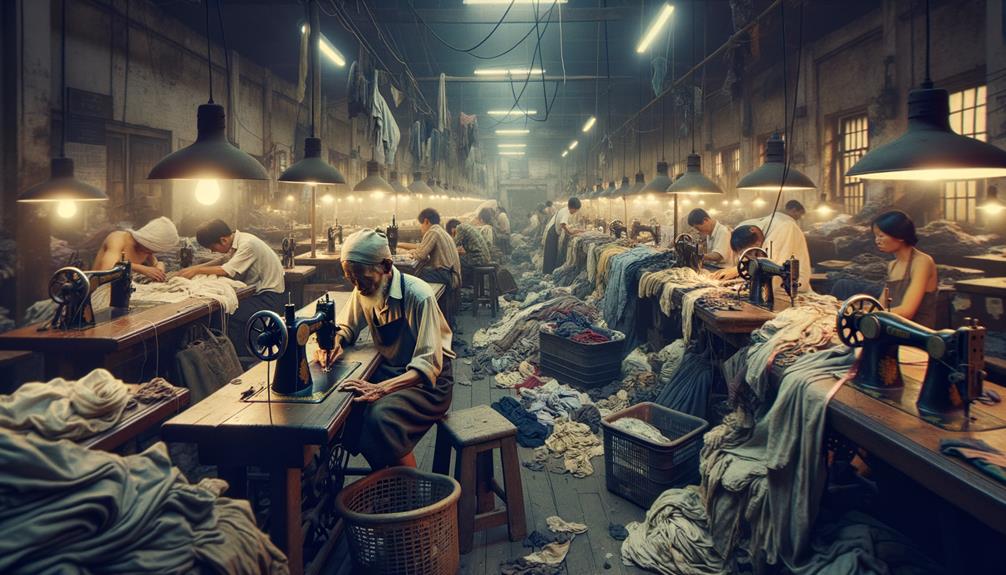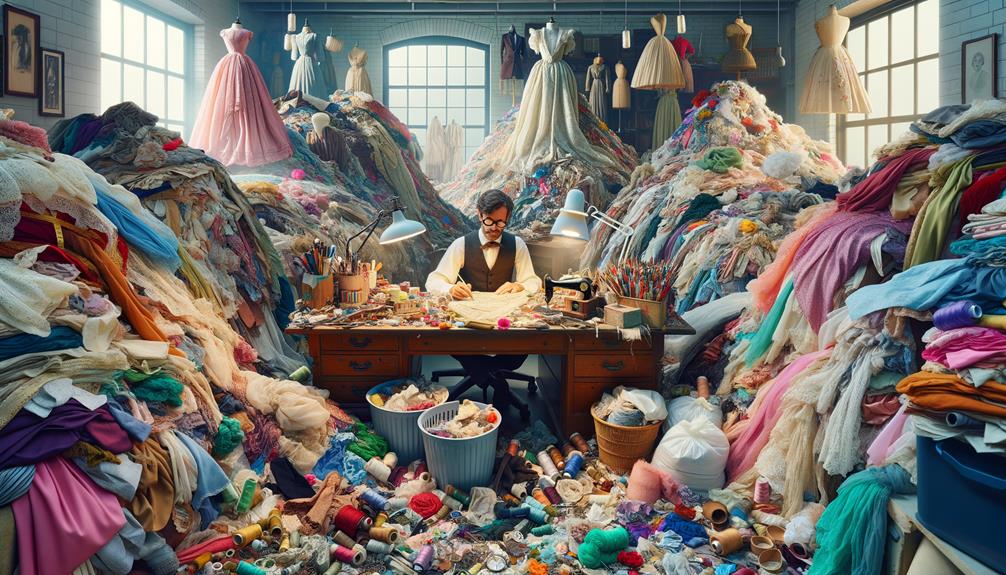In the fashion industry, efforts to conserve and protect textiles face significant challenges. Our sector often leaves a heavy environmental impact, from carbon emissions to microplastic pollution and water consumption. Behind each garment, hidden labor and silenced voices are woven in, with workers facing grueling conditions. Toxic dyes contaminate waterways, while synthetic fibers threaten future sustainability. The mountains of discarded fast fashion are a haunting reminder of the waste in our system.
Yet, there is hope in sustainable practices and recycled materials. The true purpose of fashion conservation goes beyond simply preserving beauty – it's about awakening a sense of responsibility. By addressing these issues head-on, the industry can uncover meaningful ways to reduce its environmental footprint and support ethical production. Though the path forward may not be easy, there is much more to discover and improve upon.
Environmental Impact
The fashion industry has a heavy environmental toll, contributing 10% of global carbon emissions. Behind every garment lies a complex web of supply chains and manufacturing processes, each stitch and seam adding to the industry's environmental impact.
Synthetic fabrics like polyester and nylon shed microplastics, silently infiltrating our oceans and waterways. The staggering water usage for a single cotton t-shirt, around 2,700 liters, highlights the unsustainable nature of our clothing consumption. With 92 million tons of textile waste discarded annually, our closets brimming with fast fashion mask a troubling reality.
Brands often resort to destroying unsold apparel, releasing toxic chemicals that taint our air and soil. The glamorous facade of the global fashion industry hides its darker side – greenhouse gas emissions and environmental degradation.
The urgent need for environmental sustainability is clear. We must reimagine our approach, transforming the ephemeral dance of fashion into a harmonious waltz with nature.
Labor Exploitation

Amid the glamour of fashion, countless stories of exploited labor stain the fabric of our clothes. The supply chains of many brands conceal forced labor, hidden from consumers and governments.
Factory workers, primarily women, toil long hours for minimum wages that barely meet their basic needs. This isn't just an economic issue – it's a tapestry of human rights violations that demands attention. The suppression of unions strips these workers of the power to advocate for better conditions.
These stories are often muffled, their voices drowned by the relentless demand for cheaper, faster fashion. As we pursue innovation, we must confront these uncomfortable truths. Our progress shouldn't come at the cost of another's dignity. The true price of fashion lies in the unseen lives and untold sacrifices behind every stitch.
Toxic Chemicals

Just as the hands that craft our garments are often overlooked, the toxic chemicals that seep into the threads also go unnoticed, quietly impacting our health and the environment. The fashion industry's reliance on synthetic fibers and complex dyeing and finishing techniques comes at a steep environmental cost. One can't help but ponder the unseen journey of our clothes, from production to pollution.
Consider the following:
- Water Pollution: The dyeing and finishing processes are rife with toxic chemicals that contaminate water supplies, affecting both ecosystems and communities.
- Water Contamination: Runoff from clothing production often carries hazardous substances, infiltrating our rivers and oceans.
- Environmental Impacts: The widespread use of synthetic fibers not only depletes resources but also leaves a lasting, toxic imprint.
It's easy to overlook these environmental impacts when we're captivated by the latest trends. But every thread, every vibrant hue, carries an unseen burden. There is a growing yearning for sustainable materials and innovations that balance beauty and responsibility. The fashion industry's current practices may seem deeply rooted, but the winds of change are stirring. It's time we acknowledge the hidden costs and demand a transformation towards a more sustainable future.
Waste Management

Beneath the glamour of fashion lies a relentless tide of waste that challenges our planet. Every second, a truckload of clothing is discarded, a stark reminder of the industry's environmental impact. Fast fashion, with its ceaseless churn of trends, leaves behind mountains of waste destined for landfills.
The materials used in these garments are a concern. Synthetic fibers dominate, and as they degrade, they release microplastics into our oceans and landfills, poisoning ecosystems. The decay of clothing in landfills also emits methane, a potent greenhouse gas, and leaches toxic chemicals and dyes into the earth.
The waste problem extends beyond just discarded clothing. Unsold garments, often incinerated, pollute the air, releasing microplastics and exacerbating global warming. This cycle of waste underscores the urgent need for sustainability in fashion. Brands must rethink the fabrics they use, not just focus on energy efficiency and minimal packaging.
In the dance between style and sustainability, the fashion industry's choices ripple through our environment, urging innovative solutions for a more harmonious future.
Sustainable Practices

In the fashion industry, sustainable practices are reshaping the landscape. Brands are turning to recycled materials and organic cotton, responding to consumers who demand more eco-friendly options. Recent surveys indicate that 85% of people prefer sustainable fashion choices.
This shift goes beyond just materials – it's about the stories our clothes tell. Initiatives like the Fashion Revolution movement are pushing for greater transparency, compelling brands to disclose their production processes and ensure ethical manufacturing.
Sustainable fashion also often means higher-quality clothing, a contrast to the disposable nature of fast fashion. Embracing secondhand, swapped or rented garments can significantly reduce clothing waste.
While sustainable brands may carry a higher price tag, they offer a smaller environmental footprint and greater durability. As we navigate this evolving fashion landscape, our choices today will determine the legacy we leave behind. It's time to make mindful decisions that align with our values and shape a more sustainable future for the industry.
Frequently Asked Questions
What Are the Challenges of Sustainability in the Fashion Industry?
Sustainability in fashion is a complex issue. We're grappling with overconsumption, synthetic fibers polluting our oceans, and overlooked workers' rights. Pursuing change means re-examining every aspect of this industry – from the materials used to the people involved.
The fashion industry's environmental impact is staggering. Textile production is a major contributor to global greenhouse gas emissions, water pollution, and waste. Many common fabrics, like polyester and nylon, are derived from non-renewable fossil fuels and can take centuries to decompose. Fast fashion's focus on cheap, trendy clothes has fueled a culture of disposability, with garments often worn a handful of times before being discarded.
Beyond the environmental toll, the industry has long been plagued by labor rights abuses. Garment workers, often in developing countries, face unsafe working conditions, low wages, and limited bargaining power. Efforts to improve transparency and accountability have been slow, with many brands still reluctant to share details about their supply chains.
Addressing these challenges requires a fundamental shift in how the fashion world operates. Designers and brands must rethink their sourcing, production, and distribution practices. Consumers, too, need to adjust their buying habits and demand more sustainable options. It's a daunting task, but one that's crucial for the future of the planet and the people who make our clothes.
What Is the Biggest Challenge in the Fashion Industry?
The biggest challenge in the fashion industry is the relentless cycle of fast fashion. This insatiable demand for constant newness fuels overconsumption and waste, making it difficult to envision a future where creativity doesn't come at the expense of the environment. The industry's unsustainable pace leaves little room for solutions that prioritize sustainability and ethical practices. Transitioning to a more responsible model that balances design innovation with environmental consciousness remains a complex and pressing issue for fashion brands and consumers alike.
What Are 3 Impacts That the Fashion Industry Has on the Environment?
The fashion industry has a significant impact on the environment. Firstly, the industry's use of synthetic dyes pollutes waterways, contaminating aquatic ecosystems. Secondly, the proliferation of microplastics from synthetic fabrics like polyester accumulates in our oceans, posing a threat to marine life. Thirdly, the demand for raw materials like cotton and leather contributes to deforestation, depleting natural resources.
What Are the Barriers to Sustainable Fashion Consumption?
Navigating the world of sustainable fashion can feel like wandering through a maze. High costs, hidden truths, and tempting fast-fashion options often obscure the path forward. It's a journey against the current, seeking clarity and balance in a society driven by instant gratification.
The barriers to sustainable fashion consumption are complex. The price tag of ethical clothing can be a significant deterrent, as many consumers are accustomed to the low prices of mass-produced fashion. Additionally, the lack of transparency in the industry makes it challenging for shoppers to understand the true impact of their purchases.
Furthermore, the convenience and accessibility of fast-fashion retailers make it easy to succumb to the allure of cheap, trendy clothing. Breaking this habitual pattern requires dedication and a shift in consumer mindset.
Addressing these barriers will be crucial in driving a more sustainable fashion future. Increased education, greater transparency from brands, and incentives for consumers could all play a role in overcoming the obstacles to sustainable fashion consumption.
Conclusion
Reflecting on fashion conservation, I'm struck by a startling statistic: the industry generates 92 million tons of waste annually. That's a heavy reminder of our environmental footprint. We can't ignore the labor exploitation and toxic chemicals woven into our clothes. Yet, there's promise in sustainable practices – a glimmer of hope in this intricate tapestry. We must tread lightly, with mindful steps, to ensure our fashion choices echo our respect for the world and its people.




